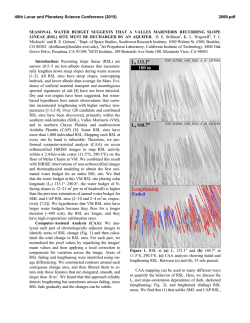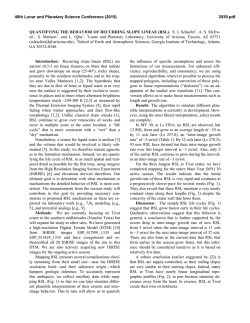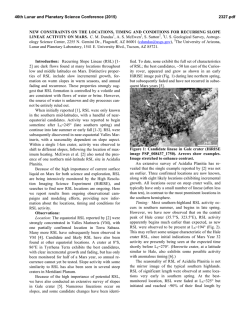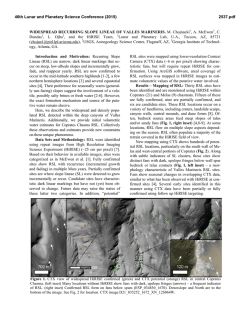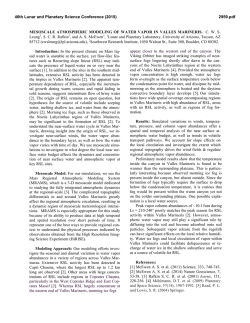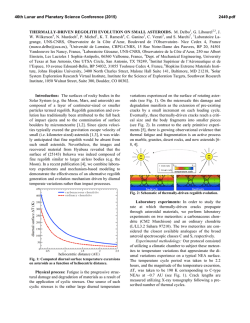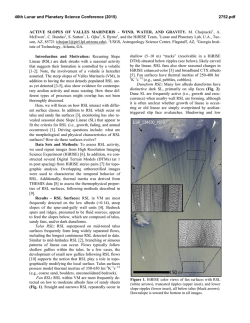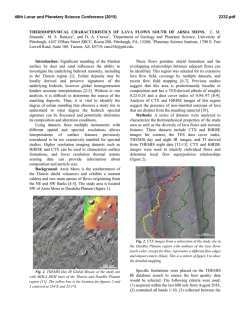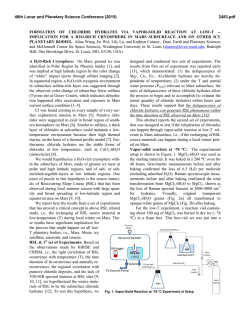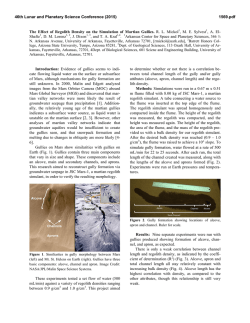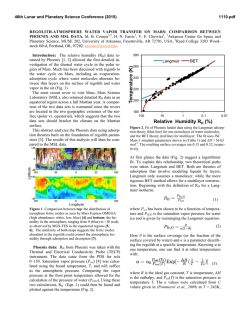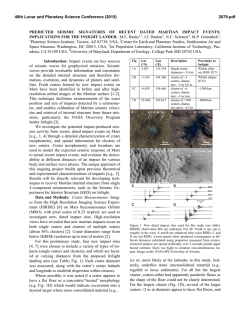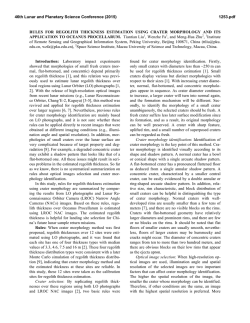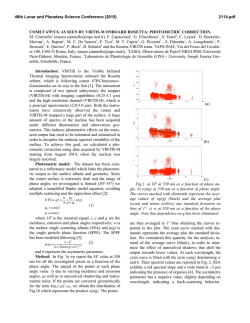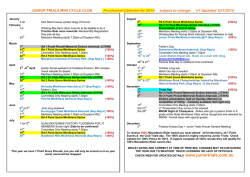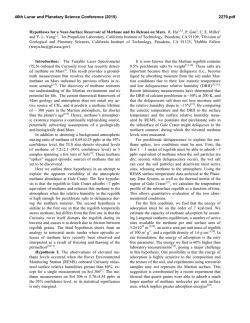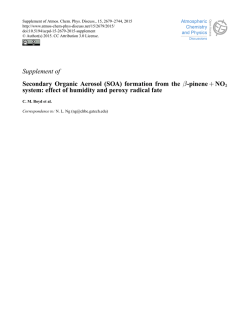
The Water Content of Recurring Slope Linea on Mars
46th Lunar and Planetary Science Conference (2015) 2286.pdf THE WATER CONTENT OF RECURRING SLOPE LINEAE ON MARS. C. S. Edwards1 & S. Piqueux2; 1 United States Geological Survey, Astrogeology Science Center, Flagstaff, AZ, [email protected]; 2Jet Propulsion Laboratory, California Institute of Technology, Pasadena, CA. Introduction Evidence for ancient flowing water on the surface of Mars is widespread and varied [1-3], but present day liquid water may only be transient, briny, and confined to limited areas where solar insolation and temperatures are maximal [4-6]. In particular, Recurring Slope Linea (RSL observed on warm Martian slopes (Fig. 1) are meter-scale seasonally recurring dark flow-like features [7-9], potentially associated with liquid water. Other hypotheses for the formation of these features have been proposed, including dry granular flows and seasonal oscillations of near-surface adsorbed water [7]. Numerical models, laboratory work, and Antarctic analogues corroborate the liquid water-brine hypothesis for these flows [4, 11, 12]. The seasonality of RSL is also not consistent with recurring granular flows or absorption of atmospheric vapor [7, 9], as RSL are most active during low atmospheric water vapor seasons [13]. For these reasons, the liquid water-brine hypothesis is favored by the community and is adopted as a testable formation mechanism in this study. So far, the direct spectral signature of water (liquid or solid) has not been identified in RSL, supporting the hypothesis that these features involve small amounts of liquid [7, 14, 15]. Placing quantitative constraints on the water content of RSL would greatly help understanding their formation mechanism, but is difficult and todate has only been limited to morphological observations and models[5]. Methods In this study, we quantify the amount of water associated with RSL using nighttime surface temperature data from THEMIS analyzed in conjunction with (near)surface heat transfer numerical modeling [16] incorporating predicted thermophysical properties of wet regolith under Martian pressure/temperature conditions. Seasonal temperature variations between RSLdense terrains compared to nearby dry regolith is used as the pixel-to-pixel calibration of THEMIS is <~1K (NE∆T @ 180K) and minimized the effects of a variable an difficult-to-remove atmosphere. This temperature difference between dry regolith and RSL dense terrains is shown in Fig. 2 in the form of a surface temperature difference, hereafter ∆T. For this work, we focus on constraining the water content of RSL in a well characterized RSL-bearing region in Valles Marineris on the walls of an unnamed crater [9], where extensive daytime and nighttime THEMIS, HiRISE, and Context Imager (CTX) coverage already exists. In addition to having been previously characterized in detail [9], this area is suitable for further thermal analysis with THEMIS as it displays: 1) limited bedrock outcrops at the origination of the RSL, avoiding anisothermal behaviors with the finer slope materials ; 2) high density of RSL terrain versus dry slope material (up to 88%, typically >40% of a THEMIS pixel) maximizing wet regolith signal versus nearby dry material; 3) an extensive areal region, encompassing multiple THEMIS 100 meter pixels (Fig. 1); and 4) multi year seasonal THEMIS coverage (Fig. 2, data from individual years are not explicitly required as RSL occur in the same general regions year to year [7]). THEMIS surface temperature observations of the crater in VallesThe Marineris span the full Martian Year, including times when RSL are actively growing, during minor growth, fading, or not active (Fig. 2). Fig. 1. Observations of the RSL containing crater in Valles Marineris centered at ~290.3˚E, 11.5˚S[9]. A) Colorized MOLA elevation[10] overlain on the THEMIS daytime temperature global mosaic B) CTX image C-E) HiRISE observations spanning Ls ~133 to 235 showing the generalized RSL progression in the region (Fig. 2) and locations of THEMIS observations 46th Lunar and Planetary Science Conference (2015) 2286.pdf RSL vs. Dry Regolith Seasonal THEMIS Nighttime Temperatures 0 300 3 300x300m Average ∆T Mars Year 32 Mars Year 31 Mars Year 30 Mars Year 29 Mars Year 28 Mars Year 27 Mars Year 26 100m/pixel ∆T± 0.5K Dry Regolith Model 1 1-σ in + a strum vg err ent or 0 No high quality nighttime data coverage > Ls 298˚ -1 Thermal Inertia Increase (%) ∆ Temperature (K) 2 250 Amount of Water (wt %) 1.5 2 2.5 3 3.5 4 A) 50 J m-2 K-1 s-1/2 100 J m-2 K-1 s-1/2 150 J m-2 K-1 s-1/2 200 J m-2 K-1 s-1/2 250 J m-2 K-1 s-1/2 200 150 100 0 1 Local Time 0315-0330 0345-0400 0400-0415 0415-0430 0430-0445 Generalised RSL Activity from HiRISE 0445-0500 0500-0515 0530-0545 Avg. Difference ± 1σ 0 -0.3 ± 0.4 0 50 100 200 150 Solar Longitude (˚Ls for all Mars years) 250 Active Minor Growth Fading/ No Detection 300 350 Fig. 2 ∆T vs Ls for all THEMIS nighttime band 4 & 9 integrated temperature images covering the crater in Fig. 1. (Top) Data from all Mars years are shown as different color points on the black line. Average data are from two 300x300m regions on the most active RSL location (Fig. 1, white box) and nearby dry regolith location (Fig. 1, black box). All temperatures are referenced to the dry regolith, including the individual, 100m/pixel data. The estimated error in the measurement accounting for the 1-σ standard deviation of the average 3x3 pixel (~300x300m) box and ~0.5K relative uncertainty of THEMIS measurements (orange). The grey dashed line is a model temperature curve simulating the dry regolith temperature variations expected from subtracting the model temperatures of different azimuths on and off the RSL locations in Fig. 1. This model accounts for variations in individual image local time, Ls, on/off RSL albedo (0.168; 0.152 respectively), slope and azimuth of each locations (30˚, 305; 30˚, 290˚ respectively), and THEMIS derived dry regolith inertia (230 J K-1 m-2 s-1/2). (Bottom) The difference between the THEMIS measured and dry-regolith model ∆T is shown, Local time is shown as grayscale points. Results and Implications Water (solid/liquid) has a significant effect on the thermophysical properties of particulate regolith by increasing the bulk thermal conductivity, specific heat, and density, resulting in high thermal inertias and unique diurnal/seasonal temperature signatures. For this reason, surface temperatures and their seasonal variations are sensitive to small amounts of pore-filling water and represent an ideal measurable quantity to characterize the water content of RSL. Over multiple years of monitoring with THEMIS nighttime data, no distinct thermal signal between wet (i.e. RSL bearing) and dry (i.e. nearby non RSL bearing) terrains is detected (Fig. 2) within the instrument detection limits (~1K), regardless of season. Numerical modeling of wet regolith under martian conditions of temperature and pressure indicates that terrains containing at least ~50 kg of water per m3 of regolith, or roughly 0.5-3 wt% (depending on wet layer thickness) should have such a distinct thermal behavior. We conclude that the RSL-bearing terrains must be mm thin and contain ~50 kg of water per m3 of regolith, or roughly 3 wt% at most, or have any thickness but contain <6 kg of water per m3 of regolith. 0.10 100 B) 0.09 90 Wet Layer Thickness (m) % RSL in a THEMIS pixel Measured-Modelled Temperature Difference (K) 1 50 -2 -1 0.5 0.08 80 0.07 70 0.06 60 0.05 50 0.04 40 1K Detection Threshold 0.03 30 0.02 20 0.01 10 0 0 0 10 20 30 40 50 Amount of Water (kg per m3 of soil) 0 60 70 5 10 15 Temperature Increase (K) Fig. 3. A) Thermal inertia increase (in %) versus amount of interstitial liquid water for five particle sizes consisting of 20 µm, 40µm, 100 µm, 240 µm, and 400 µm (50, 100, 150, 200, and 250 J K-1 m-2 s-1/2, respectively). B) Modeled nighttime (0449 local time, 174 Ls) ∆T as a function of the wet layer thickness (Y axis) and amount of water (X axis). This result is consistent with the morphological modeling of [5] and is also consistent with expected seasonal albedo changes from wetting followed by freezing of small amounts of pore filling water [14]. The lack of a visible/near-infrared spectral signature attributable to water, as a fluid, solid, or in mineral structures [15], is also consistent with our results, as such low wt %s would likely have a small spectral contribution. The lack of spectral detection of cementing salts (expected to build up over time), coupled with the local thermal inertia values (i.e. ~230 J m-2 K-1 s-1/2, only consistent with fine uncemented regolith) and high peak daytime temperatures (well above 273K), lead us to conclude the RSL in this area are associated with fresh water [6]. Irrespective of salinity, these flows experience diurnal/seasonal freeze/thaw and/or complete evaporation/sublimation cycles that may hinder their habitability. References [1] M. H. Carr, G. D. Clow, (1981) Icarus 48, 91. [2] P. R. Christensen, (2003) Nature 422, 45. [3] J.-P. Bibring et al., (2006) Science 312, 400. [4] V. F. Chevrier, E. G. RiveraValentin, (2012) Geophys Res Lett 39, L21202. [5] R. E. Grimm et al., (2014) Icarus 233, 316. [7] A. S. McEwen et al., (2011) Science 333, 740. [8] L. Ojha et al., (2014) Icarus 231, 365. [9] A. S. McEwen et al., (2014) N. Geo. 7, 53. [10] D. E. Smith et al., (2001) JGR 106, 23689. [11] A. Wang et al., (2013) LPSC 1719, 2606. [12] J. Dickson, J. Head, LPSC, 2012. [13] M. D. Smith, (2002) JGR 197, 5115. [14] H. Zhang, K. J. Voss, (2006) Applied Optics 45, 8753. [15] L. Ojha et al., (2013) GRL 40, 2013GL057893. [16] H. H. Kieffer, (2013) JGR 118, 451.
© Copyright 2025
